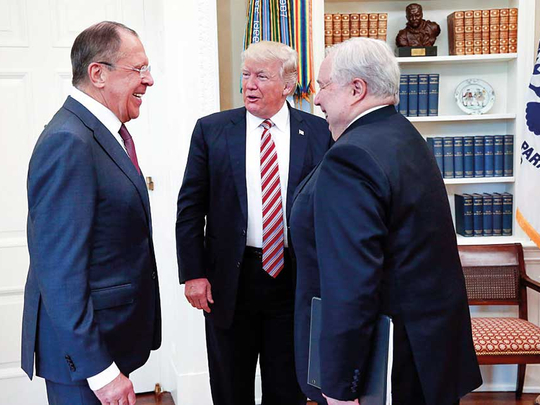
WASHINGTON: President Donald Trump appeared to acknowledge on Tuesday that he revealed highly classified information to Russia — a stunning confirmation of a Washington Post story and a move that contradicted his own White House team after it scrambled to deny the report.
Trump’s tweets tried to explain away the news, which emerged late on Monday, that he had shared sensitive, “code-word” information with the Russian foreign minister and ambassador during a White House meeting last week, a disclosure that intelligence officials warned could jeopardise a crucial intelligence source on the Daesh group.
Closed to all media
Trump described his talks with the Russians as “an openly scheduled” meeting at the White House. In fact, the gathering was closed to all US media, although a photographer for the Russian state-owned news agency was allowed into the Oval Office, prompting national security concerns.
“As President I wanted to share with Russia [at an openly scheduled W.H. meeting] which I have the absolute right to do, facts pertaining to terrorism and airline flight safety,” Trump wrote yesterday morning. “Humanitarian reasons, plus I want Russia to greatly step up their fight against ISIS [Daesh] & terrorism.”
Trump’s tweets undercut his administration’s frantic effort on Monday night to contain the damaging report. The White House had three senior administration officials — national security adviser H.R. McMaster, deputy national security adviser Dina Powell and Secretary of State Rex Tillerson — attack the reports.
The president’s admission follows a familiar pattern. Last week, after firing FBI Director James Comey, the White House originally claimed that the president was acting in response to a memo provided by Deputy Attorney General Rod J. Rosenstein.
But in an interview with NBC’s Lester Holt, Trump later admitted that he had made the decision to fire Comey well before Rosenstein’s memo, in part because he was frustrated by the director’s investigation into possible collusion between his presidential campaign and the Russian government.
At the time, Trump was surprised by the almost universal bipartisan backlash to his decision, and he raged at his staff, threatening to shake up his already tumultuous West Wing. His communications team — Communications Director Mike Dubke and press secretary Sean Spicer — bore the brunt of the president’s ire.
On Monday night, following the Washington Post story, the president again was frustrated with Dubke and Spicer, according to someone with knowledge of the situation.
But his decision on Tuesday to undermine his own West Wing staff in a series of tweets is unlikely to help him bring stability to his chaotic administration, just days before he departs on a 10-day trip abroad.
In a later tweet, Trump returned to one of his favourite topics when accused of wrongdoing — leaks.
“I have been asking Director Comey & others, from the beginning of my administration, to find the LEAKERS in the intelligence community,” Trump wrote.
The irony seemed to be lost on Trump that — at least in the case of sharing classified intelligence with the Russians — he was, in fact, the original leaker.
Explosive information
Because the president has broad authority to declassify information, it is unlikely that his disclosures to the Russians were illegal — as they would have been had just about anyone else in government shared the same secrets. But the classified information he shared with a geopolitical foe was nonetheless explosive, having been provided by a critical US partner through an intelligence-sharing arrangement considered so delicate that some details were withheld even from top allies.












